Annual flowers are a great option if you’re looking for easy ways to add color and beauty to your garden! Outdoor annuals come in many colors and varieties, so you’re sure to find the perfect ones for your outdoor space. Not sure which annual flowers are right for you? Here is our list of the ten best outdoor annual flowers that are favorites among gardeners of all experience levels. Plus, check out our easy tips for successful annual gardening at the end of this article.
1. Calendula (Calendula officinalis)

Calendula plants bloom continuously from early summer until fall, making for lovely cut flowers.
©Yulia_B/Shutterstock.com
Also called pot marigold, calendula is a flowering herb known for its medicinal properties. However, don’t confuse calendula with the common garden marigold. This outdoor annual flower also has orange, white, or yellow blooms like common marigolds, but it’s part of the daisy family. And it’s a beautiful flower that’s easy to grow!
Calendula plants bloom continuously from early summer until fall, making for lovely cut flowers. They’re also drought-tolerant, which makes them a perfect choice for hot, dry summers. If you have pets or kids, calendula is also a good choice since it’s not toxic to animals or humans.
To plant calendula, sow the seeds directly in your garden in early spring. Calendula prefers full sun but will also grow with some light shade. Once the plants are established, they’re relatively low-maintenance. Deadheading (removing spent flower heads) will encourage continuous blooming. Also, this outdoor annual flower performs best in hardiness zones 2-11.
2. Cosmos (Cosmos bipinnatus)

Cosmos are easy annual flowers to start from seed and will self-sow (producing new plants from dropped seeds) if you let them.
©iStock.com/Passakorn_14
There are many varieties of cosmos, in colors ranging from blue to yellow to hot pink. Their round daisy-like blooms grow on tall stems, making them perfect for cutting and adding to bouquets.
Cosmos are easy annual flowers to start from seed and will self-sow (producing new plants from dropped seeds) if you let them. They prefer full sun but can also take some light shade. These hardy annuals are drought-tolerant and aren’t particular about soil type, making them a great choice for beginning gardeners. Cosmos plants will bloom all summer long if you deadhead them regularly. Note that cosmos are hardy in zones 2-11.
3. Geranium (Geranium x oxonianum)
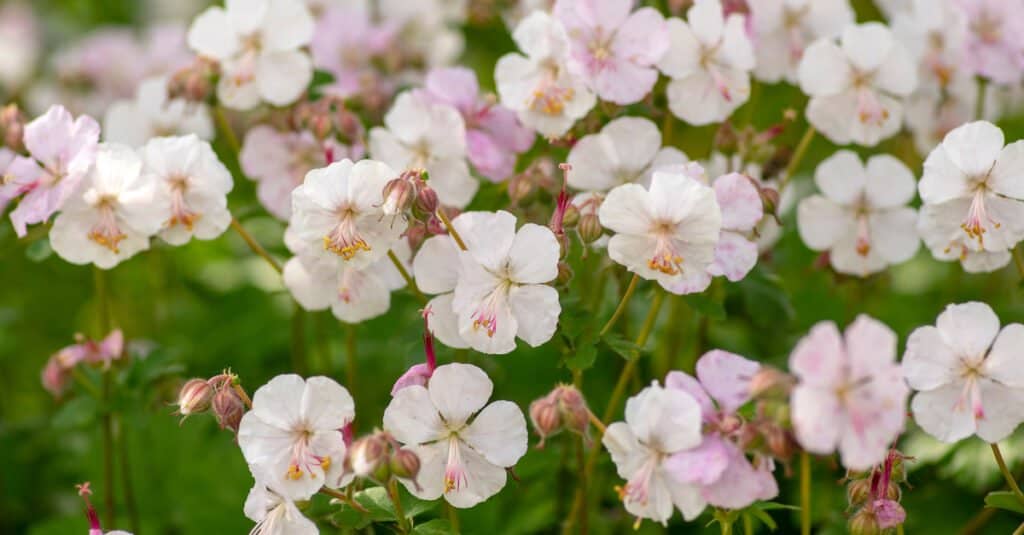
Geraniums are outdoor annual flowers that prefer full sun but will also tolerate some light shade.
©Iva Vagnerova/Shutterstock.com
Geraniums are a classic annual flower that comes in many colors, like white, pink, purple, and red. They have a strong, mounded growth habit, and their blooms last all summer. Their petals are often ruffled or veined, which gives them a beautiful texture.
Geraniums are outdoor annual flowers that prefer full sun but will also tolerate some light shade. They’re not picky about soil type but need well-draining soil to prevent root rot. These annual flowers are drought-tolerant and don’t require much fertilizer. To encourage continuous blooming, remove spent flower heads regularly. Geraniums are hardy in zones 3-9.
Did you know that you can grow geraniums indoors too? Here are a few quick tips for bringing your potted geraniums inside:
- First, choose a location in your home that gets plenty of light. Geraniums need at least six hours of sunlight each day to bloom their best.
- Next, ensure you have a large enough pot for your plant. The general rule of thumb is to use a pot about two inches wider than the plant’s root ball.
- And finally, don’t forget to fertilize your geraniums regularly. They’re heavy feeders and need regular doses of nutrients to stay healthy and bloom continuously.
4. Impatiens (Impatiens walleriana)
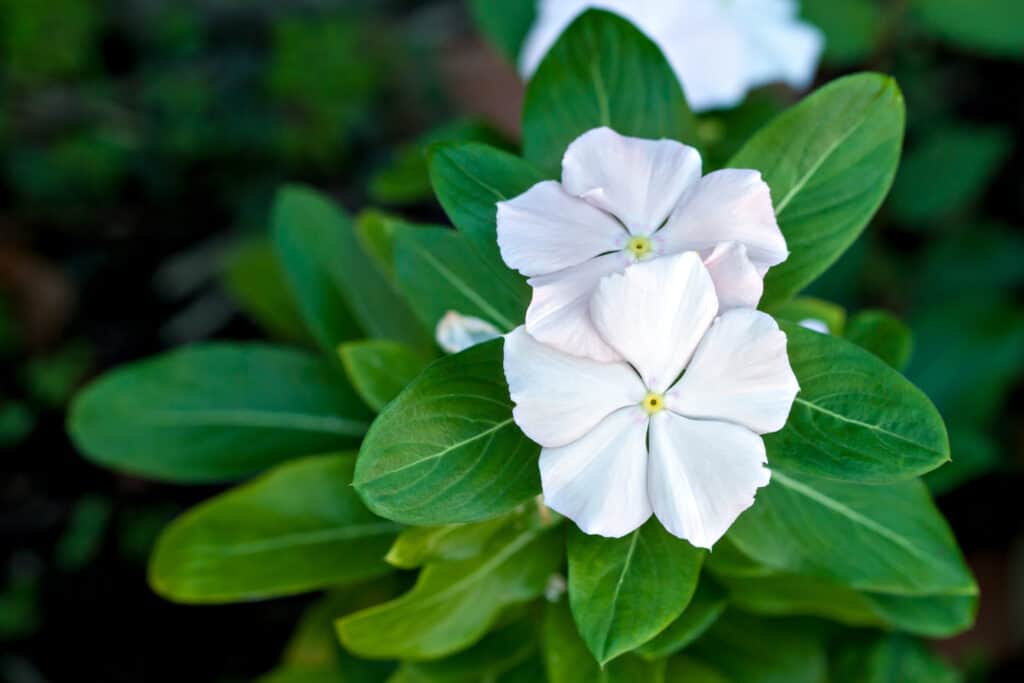
Impatiens quickly grow from seed or transplants and prefer moist, well-draining soil.
©Tikta Alik/Shutterstock.com
Shade-loving impatiens are a popular annual flower for gardens and containers. Their most common colors include white, pink, purple, red, and orange. And their glossy leaves add a touch of texture to shady areas of the garden.
Love pink flowers? Impatiens walleriana ‘Rockapulco Appleblossom’ cultivar fills pots and garden beds with many soft pink double blooms. Or, if you prefer a bright purple variety, consider growing Impatiens walleriana ‘Rockapulco Purple.’
Impatiens quickly grow from seed or transplants and prefer moist, well-draining soil. They also need partial to full shade to prevent their leaves from scorching in the hot summer sun. These annual flowers are not drought-tolerant and must be watered regularly, especially during periods of extended heat. Also, impatiens are not tolerant of frost, so plant them after the last frost date in your area. In addition, impatiens are hardy in zones 2-11.
5. Lobelia (Lobelia erinus or Lobelia cardinalis)
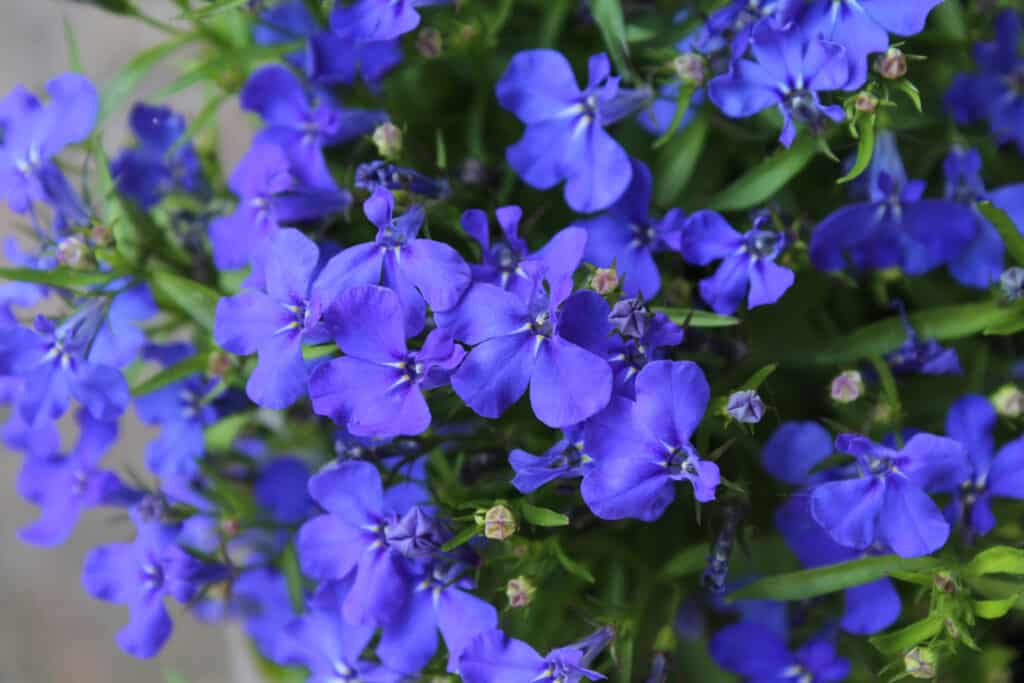
Lobelia’s dainty flowers appear on thin stems above oval-shaped leaves.
©iStock.com/Imladris01
The lobelia is a low-growing outdoor annual flower that’s perfect for edging gardens, walkways, and patios. There are upright and trailing varieties in various colors, like red and blue. Lobelia’s dainty flowers appear on thin stems above oval-shaped leaves. And they bloom continuously from summer until the first frost in fall.
Lobelia is also called the trailing lobelia or cardinal flower. Trailing lobelia (Lobelia erinus) is perfect for pots, hanging baskets, and window boxes allowing cascading plants. Additionally, cardinal flower varieties of lobelia plants (Lobelia cardinalis) grow upright to about 4 inches tall, depending on the cultivar. The cardinal flowers bloom on spikes packed full of tiny petals.
All varieties of this pretty plant prefer full to partial sun and require well-draining soil. Unfortunately, these annual flowers are not drought-tolerant. As a result, their soil should be kept moist. Lobelia is hardy in zones 3-9.
6. Marigold (Tagetes spp.)
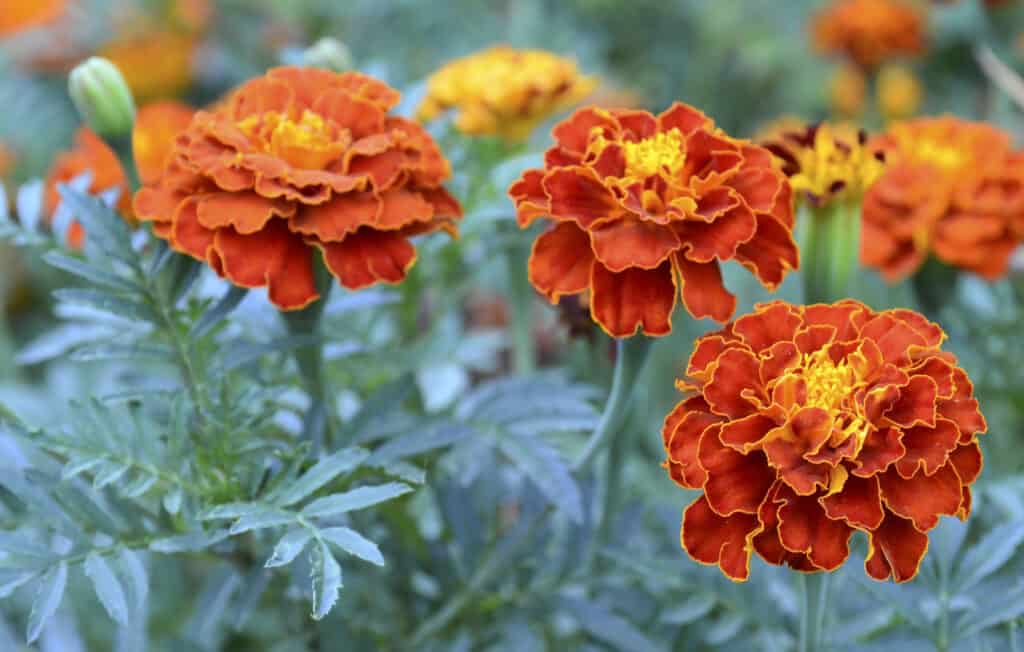
Marigolds are bright and cheery flowers that are easy to care for.
©iStock.com/svf74
Marigolds are annual flowers that most commonly come in yellow, orange, and red. Some varieties also have bicolor blooms or single petals with colored edges. The size of marigold flowers can vary depending on the cultivar, but they typically grow to about 2-4 inches tall.
Marigolds are one of the most popular outdoor annual flowers because they’re so easy to grow. They usually need full sun but don’t need particular potting soil to bloom well and often. In addition, these annual flowers tolerate drought and bloom from summer through early fall.
There are two main types of marigolds: French marigolds (Tagetes patula) and African marigolds (Tagetes erecta). French marigolds have a mounded growth habit and grow about 12 inches tall. They’re ideal for use as bedding plants or in containers. On the other hand, African marigolds can grow up to 4 feet tall and have a more upright growth habit.
Marigolds are also a good choice for gardens because they’re known to repel pests like rabbits and deer. In addition, they’re also resistant to most diseases. And if you want to grow them as perennials that come back every year, note that marigolds are hardy in zones 2-11.
7. Nasturtium (Tropaeolum majus)
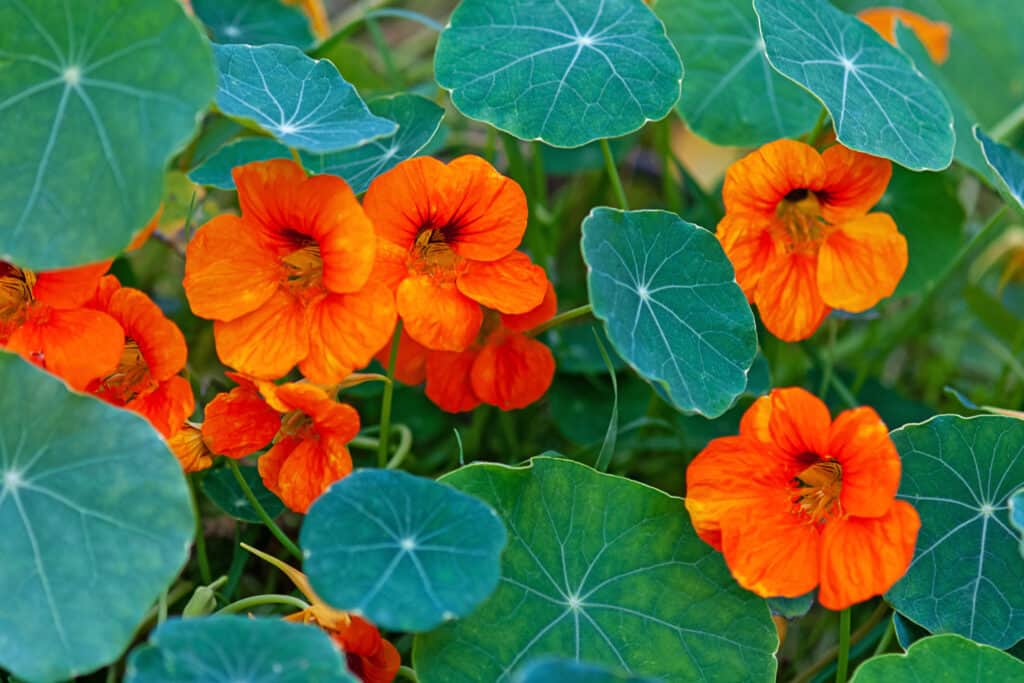
Nasturtiums are edible flowers often used to garnish salads or as a colorful addition to other dishes.
©iStock.com/Nadya So
A nasturtium plant is a good option for a flowering annual that’s easy to grow and can tolerate various growing conditions. These outdoor annual flowers come in dwarf or trailing varieties and have distinctively round or heart-shaped leaves. Their flowers are usually yellow, orange, or red, though some cultivars have bicolor blooms. And nasturtiums bloom from early summer until the first frost in fall.
Did you know that you can eat nasturtiums? They’re edible flowers often used to garnish salads or as a colorful addition to other dishes. The whole nasturtium plant is edible, including the seeds, which can be pickled and used as a substitute for capers.
Nasturtiums need full sun, are drought-tolerant, and don’t need rich soil to thrive. In fact, nasturtiums will even do well in poor, sandy soil as long as it drains well. For this reason, fertilizing is not recommended. Nasturtiums are hardy in zones 2-11.
8. Pansy (Viola x wittrockiana)

These plants are split into three basic categories by species, pansies (
Violax
wittrockiana), violets (Voila spp.), and Johnny jump-ups (Viola tricolor).
©Ken Kojima /Shutterstock.com
Pansies are popular for outdoor growing because they’re such bright and cheery small annual flowers. These petite plants usually have showy, multicolored 4-petaled flowers. The size of pansy flowers can vary depending on the cultivar, but they typically grow to be about 2-4 inches across.
Pansy plants prefer cool weather but also thrive in full sun to partial shade. In addition, they need well-draining and moderately fertile soil. Pansies are not drought-tolerant, so water them regularly. These outdoor annual flowers are hardy in zones 3-8.
Pansies are also a good choice for gardens because they’re relatively pest- and disease-resistant. In addition, pansies attract bees, butterflies, and other pollinators.
9. Petunia (Petunia x hybrida)

Many of the petunia cultivars of today have unique qualities like double blooms or colors like black or bicolor magenta.
©pakn/Shutterstock.com
Petunias are excellent annual flowers for growing in outdoor spaces. Their showy trumpet blooms grow as big as 2-4 inches in colors like white, pink, purple, red, and bicolor.
The petunia has a rich history going all the way back to its origins in the 1700s. The modern petunia was eventually created from those original small and scraggly plants. Many of the petunia cultivars of today have unique qualities like double blooms or colors like black or bicolor magenta.
There are four main types of petunias:
- Grandiflora petunias have the largest flowers and are ideal for use as bedding plants or in containers.
- Multiflora petunias have medium-sized flowers and are more tolerant of hot weather.
- Milliflora petunias have the smallest flowers with compact foliage.
- Spreading petunias spread quickly and make a fantastic ground cover.
Petunias are easy to grow with full sun and well-draining soil. Though note that petunia stems get leggy and do well when cut back once or twice per season. These outdoor annual flowers are tolerant of drought and bloom from spring through fall. In addition, petunias are relatively pest- and disease-resistant. Petunias are hardy in zones 2-11.
10. Zinnia (Zinnia elegans)

Most zinnias grow to be about 1-3 feet tall, making them ideal for use as bedding plants, in containers, or cut flower arrangements.
©Thamrong Chunivarawat/Shutterstock.com
Consider growing zinnias outdoors for bright and showy plants perfect for cut flowers. These outdoor annual flowers are available in white, yellow, pink, purple, orange, and red. Zinnias also have a variety of flower shapes, including cactus-type blooms, dahlia-type blooms, and more.
Most zinnias grow to be about 1-3 feet tall, making them ideal for use as bedding plants, in containers, or cut flower arrangements. In addition, zinnias are excellent cut flowers because they’re long-lasting and mildew resistant.
Grow zinnias in full sun and moist, well-draining soil. However, don’t grow zinnias close together because they need plenty of air circulation to thrive. Additionally, zinnias are easy to grow with few pest or disease problems. These outdoor annual flowers are hardy in zones 2-11.
Zinnias are also known to attract bees, butterflies, and other pollinators to garden beds and containers. Butterflies are especially attracted to zinnia nectar, including monarch butterflies.
Try these easy steps for growing outdoor annual flowers.
We hope this list finds you excited to grow your own outdoor annual flowers! They add lots of color to your garden and are usually easy to maintain. But if you’re a beginner gardener needing some basic tips for how to grow annuals outdoors successfully, here are some easy pointers:
1. Choose an ideal location. Annual flowers prefer full sun and well-drained soil.
2. Plant in the spring after the last frost. Though some annuals also do well planted in the fall, like cosmos, lobelia, and marigolds.
3. Water regularly. Annual flowers should be watered regularly, especially during dry periods. But don’t overwater plants like impatiens, or they might develop root rot and other diseases.
4. Fertilize annual flowers monthly with a general-purpose fertilizer. However, one exception is nasturtiums, which perform better in non-fertilized soil.
5. Deadhead regularly. Deadheading a plant is the process of removing spent flowers from the plant to encourage it to produce more flowers.
With these easy tips, you’ll be able to grow beautiful outdoor annual flowers that will add color to your garden all season long!
Up Next:
The photo featured at the top of this post is © Thamrong Chunivarawat/Shutterstock.com
Sources
- Esbenshade's Garden Centers, Available here: https://www.esbenshades.com/petunia-history/
- GARDENER'S PATH, Available here: https://gardenerspath.com/plants/flowers/grow-garden-geraniums/
- Icahn School of Medicine at Mount Sinai, Available here: https://www.mountsinai.org/health-library/herb/calendula
Thank you for reading! Have some feedback for us? Contact the AZ Animals editorial team.






